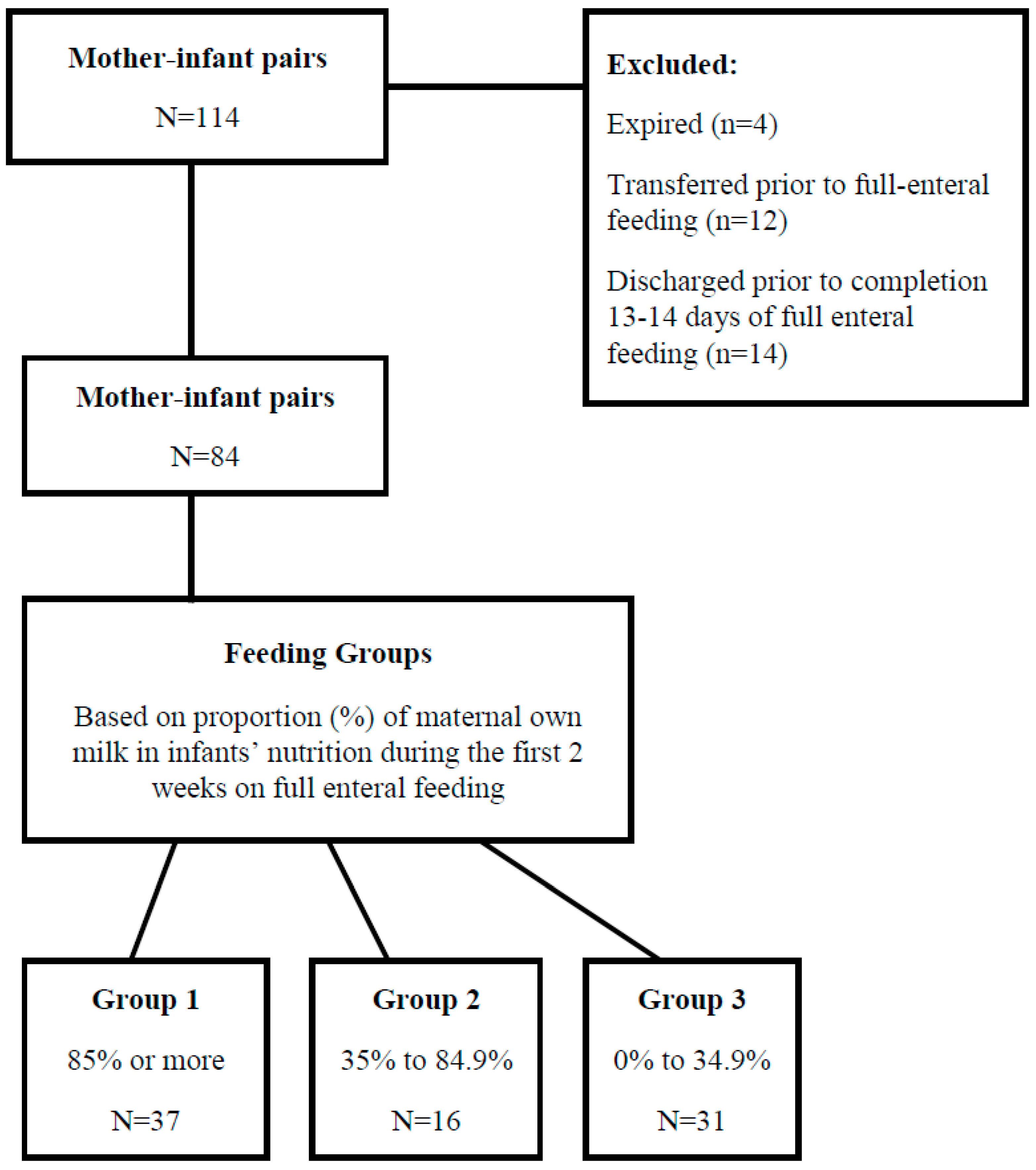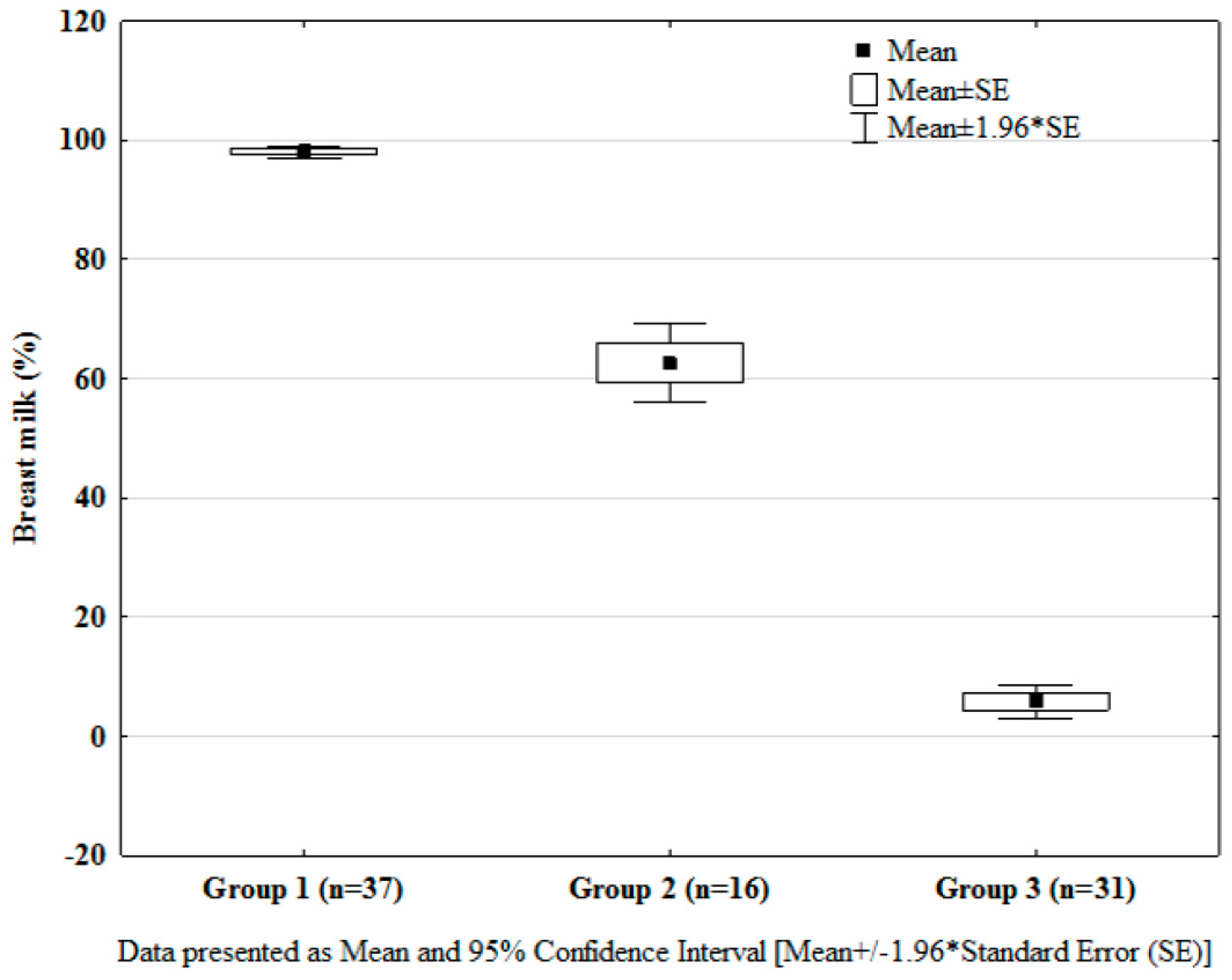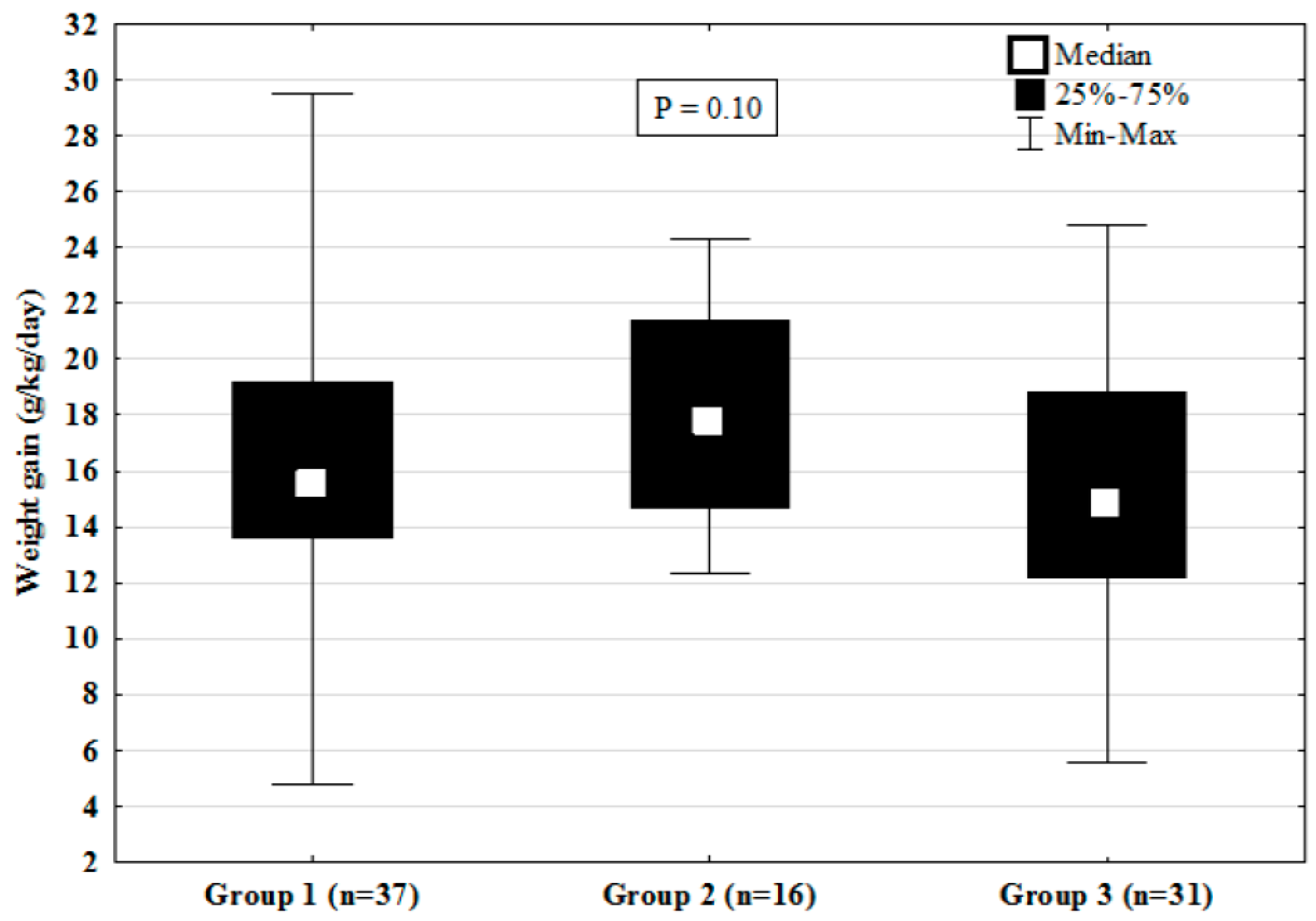Role of the Proportional Intake of Fortified Mother’s Own Milk in the Weight Gain Pattern of Their Very-Preterm-Born Infants
Abstract
1. Introduction
2. Methods
2.1. Definition of Feeding Measures
2.2. Definition of Growth Measures
2.3. Sample Size Calculation
2.4. Data Presentation and Statistical Analysis
3. Results
3.1. Weight Gain during the First 2 Weeks Post Initiation of Full Enteral Feeds
3.2. Duration of Hospitalization and Discharge Parameters
4. Discussion
5. Conclusions
Author Contributions
Funding
Conflicts of Interest
References
- Torrazza, R.M.; Neu, J. Evidence-based guidelines for optimization of nutrition for the very low birthweight infant. NeoReviews 2013, 14, e340–e349. [Google Scholar] [CrossRef]
- Higgins, R.D.; Devaskar, S.; Hay, W.W., Jr.; Ehrenkranz, R.A.; Greer, F.R.; Kennedy, K.; Meier, P.; Papile, L.; Sherman, M.P. Executive summary of the workshop “Nutritional Challenges in the High Risk Infant”. J. Pediatr. 2012, 160, 511–516. [Google Scholar] [CrossRef] [PubMed][Green Version]
- Groh-Wargo, S.; Sapsford, A. Enteral nutrition support of the preterm infant in the neonatal intensive care unit. Nutr. Clin. Pract. 2009, 24, 363–376. [Google Scholar] [CrossRef] [PubMed]
- Ehrenkranz, R.A.; Younes, N.; Lemons, J.A.; Fanaroff, A.A.; Donovan, E.F.; Wright, L.L.; Katsikiotis, V.; Tyson, J.E.; Oh, W.; Shankaran, S.; et al. Longitudinal growth of hospitalized very low birth weight infants. Pediatrics 1999, 104 Pt 1, 280–289. [Google Scholar] [CrossRef]
- Henriksen, C.; Westerberg, A.C.; Rønnestad, A.; Nakstad, B.; Veierød, M.B.; Drevon, C.A.; Iversen, P.O. Growth and nutrient among very-low-birth weight infants fed fortified human milk during hospitalization. Br. J. Nutr. 2009, 102, 1179–1186. [Google Scholar] [CrossRef]
- Belfort, M.B.; Rifas-Shiman, S.L.; Sullivan, T.; Collins, C.T.; McPhee, A.J.; Ryan, P.; Kleinman, K.P.; Gillman, M.W.; Gibson, R.A.; Makrides, M. Infant growth before and after term: Effects on neurodevelopment in preterm Infants. Pediatrics 2011, 128, e899–e906. [Google Scholar] [CrossRef]
- Euser, A.M.; de Wit, C.C.; Finken, M.J.; Rijken, M.; Wit, J.M. Growth of preterm born children. Horm. Res. 2008, 70, 319–328. [Google Scholar] [CrossRef]
- Breastfeeding and the use of human milk. Section on Breastfeeding. Pediatrics 2012, 129, e827–e841.
- Vohr, B.R.; Poindexter, B.B.; Dusick, A.M.; McKinley, L.T.; Wright, L.L.; Langer, J.C.; Poole, W.K.; NICHD Neonatal Research Network. Beneficial effects of breast milk in the neonatal intensive care unit on the developmental outcome of extremely low birth weight infants at 18 months of age. Pediatrics 2006, 118, e115–e123. [Google Scholar] [CrossRef] [PubMed]
- Dempsey, E.; Miletin, J. Banked preterm versus banked term human milk to promote growth and development in very low birth weight infants. Cochrane Database Syst. Rev. 2010. [Google Scholar] [CrossRef]
- Cristofalo, E.A.; Schanler, R.J.; Blanco, C.L.; Sullivan, S.; Trawoeger, R.; Kiechl-Kohlendorfer, U.; Dudell, G.; Rechtman, D.J.; Lee, M.L.; Lucas, A.; et al. Randomized trial of exclusive human milk versus preterm formula diets in extremely premature infants. J. Pediatr. 2013, 163, 1592–1595.e1. [Google Scholar] [CrossRef] [PubMed]
- Embleton, N.D. Optimal protein and energy intakes in preterm infants. Early Hum. Dev. 2007, 83, 831–837. [Google Scholar] [CrossRef] [PubMed]
- Quigley, M.; McGuire, W. Formula versus donor breast milk for feeding preterm or low birth weight infants. Cochrane Database Syst. Rev. 2014. [Google Scholar] [CrossRef] [PubMed]
- Meier, P.P.; Engstrom, J.L.; Patel, A.L.; Jegier, B.J.; Bruns, N.E. Improving the use of human milk during and after the NICU stay. Clin. Perinatol. 2010, 37, 217–245. [Google Scholar] [CrossRef]
- World Health Organization. Indicators for Assessing Infant and Young Child Feeding Practices. 2008. Available online: https://www.who.int/maternal_child_adolescent/documents/9789241596664/en/ (accessed on 26 February 2020).
- Labbok, M.H.; Krasovec, K. Toward a consistency in breastfeeding definition. Stud. Fam. Plan. 1990, 21, 226–230. [Google Scholar] [CrossRef]
- Noel-Weiss, J.; Boersma, S.; Kujawa-Myles, S. Questioning current definitions for breastfeeding research. Int. Breastfeed. J. 2012, 7, 9. [Google Scholar] [CrossRef]
- Pollack, M.M.; Koch, M.A.; Bartel, D.A.; Rapoport, I.; Dhanireddy, R.; El-Mohandes, A.A.; Harkavy, K.; Subramanian, K.N. A comparison of neonatal mortality risk prediction models in very low birth weight infants. Pediatrics 2000, 105, 1051–1057. [Google Scholar] [CrossRef] [PubMed]
- Olsen, I.E.; Groveman, S.; Lawson, M.L.; Clark, R.H.; Zemel, B.S. New intrauterine growth curves based on U.S. data. Pediatrics 2010, 125, e214–e244. [Google Scholar] [CrossRef]
- American Academy of Pediatrics. Nutritional needs of preterm infants. In Pediatric Nutrition Handbook, 4th ed.; Kleinman, R.E., Ed.; American Academy of Pediatrics: Elk Grove, IL, USA, 1998; pp. 55–87. [Google Scholar]
- Wojcik, K.Y.; Rechtman, D.J.; Lee, M.L.; Montoya, A.; Medo, E.T. Macronutrient analysis of a nationwide sample of donor breast milk. J. Am. Dietetic Assoc. 2009, 109, 137–140. [Google Scholar] [CrossRef]
- West, J.; Manchester, B.; Wright, J.; Lawlor, D.A.; Waiblinger, D. Reliability of routine clinical measurements of neonatal circumferences and research measurements of neonatal skinfold thicknesses: Findings from the Born in Bradford study. Paediatr. Perinat. Epidemiol. 2011, 25, 164–171. [Google Scholar] [CrossRef]
- Wood, A.J.; Raynes-Greenow, C.H.; Carberry, A.E.; Jeffery, H.E. Neonatal length inaccuracies in clinical practice and related percentile discrepancies detected by a simple length-board. J. Paediatr. Child Health 2013, 49, 199–203. [Google Scholar] [CrossRef]
- Brown, J.V.; Embleton, N.D.; Harding, J.E.; McGuire, W. Multi-nutrient fortification of breast milk for preterm infants. Cochrane Database Syst. Rev. 2016. [Google Scholar] [CrossRef] [PubMed]
- Spiegler, J.; Preub, M.; Gebauer, C.; Bendiks, M.; Herting, E.; Göpel, W.; German Neonatal Network (GNN). Does breastmilk influence the development of bronchopulmonary dysplasia? J. Pediatr. 2016, 169, 76–80. [Google Scholar] [CrossRef] [PubMed]
- Chowning, R.; Radmacher, P.; Lewis, S.; Serke, L.; Pettit, N.; Adamkin, D.H. A retrospective analysis of the effect of human milk on prevention of necrotizing enterocolitis and postnatal growth. J. Perinatol. 2016, 36, 221–224. [Google Scholar] [CrossRef] [PubMed]
- Baro, C.; Girbaldi, M.; Arslanoglu, S. Effect of two pasteurization methods on the protein content of human milk. Front. Biosci. 2011, 3, 818–829. [Google Scholar] [CrossRef]
- Fenaille, F.; Parisod, V.; Tabet, J.C.; Guy, P.A. Carbonylation of milk powder proteins as a consequence of processing conditions. Proteomics 2005, 5, 3097–3104. [Google Scholar] [CrossRef] [PubMed]
- Meier PPater, A.; Esquerra-Zwiers, A. Donor human milk update: Evidence, mechanisms, and priorities for research and practice. J. Pediatr. 2017, 180, 15–21. [Google Scholar] [CrossRef] [PubMed]



| Characteristics | Feeding Groups | p Value | ||
|---|---|---|---|---|
| Group 1 (n = 37) | Group 2 (n = 16) | Group 3 (n = 31) | ||
| Maternal Age, y * | 32.2 (30.7, 33.8) | 35.8 (32.0, 39.5) | 30.5 (28.1, 32.9) | <0.02 |
| Race/ethnicity, n (%) | n = 32 | n = 14 | n = 28 | <0.01 |
| White | 14 (43.8) | 7 (50.0) | 8 (28.6) | |
| Black | 6 (18.8) | 0 | 13 (46.4) | |
| Hispanic | 0 | 2 (14.3) | 5 (17.9) | |
| Other | 12 (37.4) | 5 (35.7) | 2 (7.1) | |
| Primipara, n (%) | 20 (54.1) | 12 (75.0) | 7 (22.6) | <0.01 |
| Primigravida, n (%) | 12/34 (35.3) | 8 (50.0) | 3 (9.7) | <0.04 |
| Singleton, n (%) | 15/36 (41.7) | 9 (56.3) | 22/30 (70.0) | 0.07 |
| Cesarean section, n (%) | 30/36 (83.3) | 11 (68.8) | 25 (80.7) | 0.44 |
| Morbidity, n (%) | ||||
| PIH,/pre-eclampsia a | 5/36 (13.9) | 8 (50.0) | 13 (41.9) | <0.01 |
| Diabetes | 1/36 (2.8) | 1 (6.3) | 3 (9.7) | 0.26 |
| Intrapartum, n (%) | ||||
| Steroids | 21 (58.3) | 12 (75.0) | 24 (80.0) | 0.14 |
| Antibiotics | 12 (32.4) | 5 (31.3) | 17 (54.8) | 0.13 |
| Magnesium Sulfate | 6 (16.2) | 2 (12.5) | 8 (25.8) | 0.58 |
| Male gender, n (%) | 19 (51.4) | 11 (68.8) | 13 (41.9) | 0.18 |
| Gestational age, week * | 27.7 (26.8, 28.6) | 29.8 (28.6, 31.0) | 29.1 (28.2, 30.3) | <0.02 |
| Birth weight, g * | 1027 (924, 1321) | 1285 (1130, 1439) | 1272 (1102, 1442) | <0.02 |
| Birth length, cm * | 35.8 (34.6, 37.1) | 38.4 (36.9, 39.9) | 37.9 (36.4, 39.3) | <0.03 |
| Head circumference, cm* | 25.4 (24.5, 26.3) | 27.0 (26.0, 28.0) | 26.5 (25.3, 27.7) | 0.102 |
| SGA b, n, % | 4 (10.8) | 2 (12.5) | 3 (9.7) | 0.95 |
| 5 min Apgar <7, n (%) | 7 (18.9) | 1 (6.3) | 9 (29.0) | 0.17 |
| Sepsis, n (%) | 15 (40.5) | 6 (37.5) | 12 (38.7) | 0.95 |
| IVH, n (%) c | 9 (24.3) | 4 (25.0) | 6 (19.4) | 0.85 |
| BPD, n (%) d | 7 (18.9) | 4 (25.0) | 4 (19.4) | 0.89 |
| PDA, n (%) e | 18 (48.6) | 4 (25.0) | 8 (25.8) | 0.09 |
| NEC, n (%) f | 2 (5.4) | 0 (0) | 1 (32) | 0.60 |
| Characteristics | Feeding Groups | p Value | ||
|---|---|---|---|---|
| Group 1 (n = 37) | Group 2 (n = 16) | Group 3 (n = 31) | ||
| Received TPN, n (%) | 26 (70.3) | 12 (75) | 17 (58.6) | 0.14 |
| PPA a of trophic feeding initiation * | 3.2 (2.5, 3.9) | 3.6 (0.2, 6.9) | 3.6 (2.2, 5.1) | 0.91 |
| PPA a to full enteral feed * | 21.6 (17.5, 25.8) | 17.4 (11.3, 33.0) | 17.4 (12.3, 22.6) | 0.25 |
| PCA b to full enteral feed * | 30.8 (30.1, 31.5) | 32.2 (31.5, 33.0) | 31.5 (30.7, 32.3) | 0.06 |
| Enteral volume intake (mL/kg/d) * | 138.2 (135.7, 141.9) | 143.3 (138.1, 148.6) | 145.9 (140.7, 151.0) | 0.05 |
| Caloric intake (kcal/kg/d) * | 113.4 (110.6, 116.2) | 114.1 (109.7, 118.4) | 115.1 (114.6, 118.7) | 0.86 |
© 2020 by the authors. Licensee MDPI, Basel, Switzerland. This article is an open access article distributed under the terms and conditions of the Creative Commons Attribution (CC BY) license (http://creativecommons.org/licenses/by/4.0/).
Share and Cite
Petrova, A.; Eccles, S.; Mehta, R. Role of the Proportional Intake of Fortified Mother’s Own Milk in the Weight Gain Pattern of Their Very-Preterm-Born Infants. Nutrients 2020, 12, 1571. https://doi.org/10.3390/nu12061571
Petrova A, Eccles S, Mehta R. Role of the Proportional Intake of Fortified Mother’s Own Milk in the Weight Gain Pattern of Their Very-Preterm-Born Infants. Nutrients. 2020; 12(6):1571. https://doi.org/10.3390/nu12061571
Chicago/Turabian StylePetrova, Anna, Shannon Eccles, and Rajeev Mehta. 2020. "Role of the Proportional Intake of Fortified Mother’s Own Milk in the Weight Gain Pattern of Their Very-Preterm-Born Infants" Nutrients 12, no. 6: 1571. https://doi.org/10.3390/nu12061571
APA StylePetrova, A., Eccles, S., & Mehta, R. (2020). Role of the Proportional Intake of Fortified Mother’s Own Milk in the Weight Gain Pattern of Their Very-Preterm-Born Infants. Nutrients, 12(6), 1571. https://doi.org/10.3390/nu12061571





